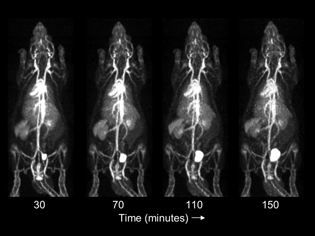News You Can Use
NIH Imaging and Probe Development Center
Synthesizing Noncommercial Probes
With its emeralds, nanodiamonds, and gold particles sparkling upon countertops and bench tops, NIH’s Imaging and Probe Development Center (IPDC) might be mistaken for a jewelry factory. But what’s being produced here is arguably more valuable than jewels, at least to the scientists that the IPDC serves. The IPDC synthesizes imaging agents—some with names like precious gems—for biomedical research and clinical applications.
A trans-NIH resource housed in the National Heart, Lung, and Blood Institute (NHLBI), the IPDC produces materials that are not commercially available. It synthesizes small molecules, peptides, and diverse nanomaterials for a range of imaging applications including fluorescence microscopy, magnetic resonance imaging, positron-emission tomography (PET), and single-photo emission computerized tomography.

CREDIT: MICHAEL V. GREEN, NCI
In one project, IPDC chemists created a F-18 labeled albumin that NCI’s Molecular Imaging Program used in PET blood-pool imaging studies that showed how injected albumin distributes throughout the body. Shown: consecutive whole-body maximum-intensity projection images of a rat following the administration of F-18 albumin. As desired, albumin labeled with this method does not accumulate in any organ except for the bladder, from where it is excreted (lower right in each image).
“We make strictly noncommercial probes,” said IPDC Director Rolf Swenson, who came to NIH from industry in 2014. And very importantly, “20 percent of the probe development is done by nontenured or new [principal investigators] who might lack their own synthetic chemistry support.”
Swenson oversees IPDC’s two labs that have state-of-the-art equipment for making novel probes: a 5,000-square-foot facility in Rockville, Maryland, and a 2,700-square-foot PET lab in the NIH Clinical Center on the Bethesda campus. The center has a combined staff of 15 chemists—including organic, medicinal, analytical, and inorganic chemists as well as radiochemists and biochemists—who have expertise in different fields of molecular imaging.
Swenson has a Ph.D. in organic chemistry from Cornell University (Ithaca, New York) and trained as a synthetic organic chemist at the University of Geneva (Geneva) and the University of Wisconsin (Madison, Wisconsin). In the biotech arena, he managed international discovery and chemistry efforts for novel imaging agents that resulted in clinical trials for a radiotherapeutic and a contrast-enhanced ultrasound product. Today, he is helping NIH scientists solve problems that are similar to ones he dealt with in industry.
Projects: In fiscal year 2014, the center had 35 projects, supported researchers in eight institutes, and synthesized 42 different compounds. In one project, the chemists created a labeled serum albumin for PET studies to see whether injected conjugates were evenly distributed throughout the bloodstream without accumulating in any organs. Another project involved labeling a candidate drug that’s used to treat the neurodegenerative disorder Niemann-Pick disease, so that the drug could be evaluated for brain uptake. Currently, the facility is doing discovery research in which the probes are mainly used in cells and animals for proof-of-principle experiments that form the basis for translational clinical imaging, research, and diagnostics.
“We are busy” but probably can absorb 10 percent more, said Swenson. The center also has the ability to work with extramural researchers who have collaborations with intramural PIs.
“It’s been a tremendous success,” said NHLBI SD Robert Balaban.
Initiating a Project: Any PI interested in having the IPDC develop a probe should first meet with Swenson or his deputy, Olga Vasalatiy, to define the scope of the project. The PIs usually have an idea about “what imaging modality they want to pursue,” said Swenson. They have a lead or an idea about what the compound could be, he added.
The IPDC and the PI jointly compose a two-page proposal, which must then be approved by the PI’s scientific director (SD) for funding, and the IPDC Steering Committee. The steering committee, made up of chemists and imaging specialists from several NIH institutes, oversees the chemical feasibility of the projects. The IPDC is supported through the SDs’ Shared Resources Subcommittee, with 25 percent of each project already paid for from a pooled fund from all the institutes and 75 percent paid for by the requesting institute, based on hours worked. Probes are typically delivered between two and six months after initiation.
The “unit cost of production is going down as more and more people are using the facility,” said Deputy Director for Intramural Research Michael Gottesman, who sees the facility as a source of expertise. “Research is altered in a positive way.”
The IPDC had its beginnings with the NIH Common Fund, which was enacted into law by Congress through the 2006 NIH Reform Act to support cross-cutting, trans-NIH programs. In 2011, the center transitioned into a core facility of the NHLBI’s intramural program. For more information, go to http://1.usa.gov/1GTWtr4.
This page was last updated on Tuesday, April 26, 2022
